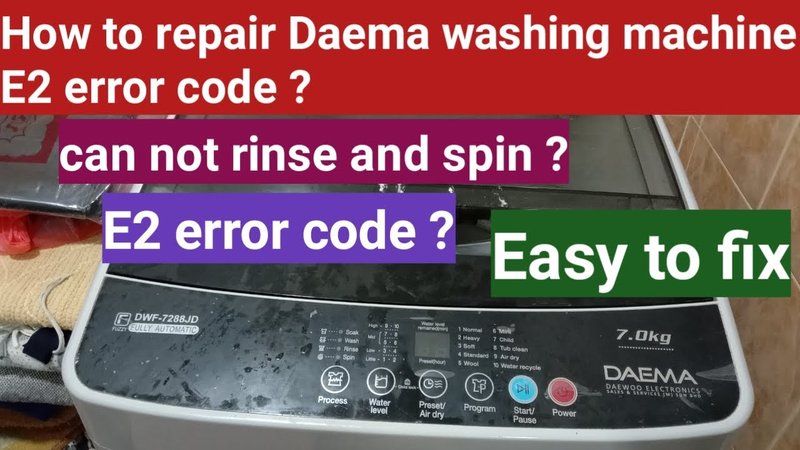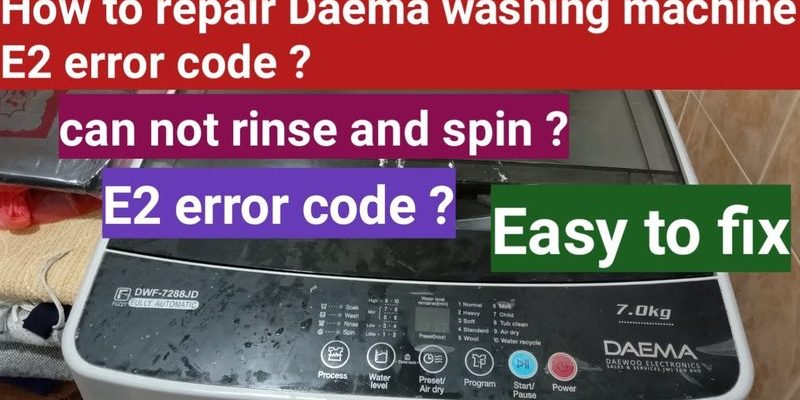
Error codes on appliances are a bit like the warning lights on your car’s dashboard. They’re there to tell you something is off and needs attention. The E2 error code on a GE washing machine is typically associated with draining issues. Think of it like trying to empty a bathtub when the drain is clogged—the water just won’t go where it’s supposed to, and that can lead to bigger problems if left unchecked. Let’s dive deeper into what this means for your washing machine and how you can tackle it without breaking a sweat.
Understanding the E2 Error Code
The E2 error code is your washing machine’s way of telling you that it’s having trouble draining water. Imagine your washing machine as a big bucket that fills with water to clean your clothes. Once it’s done washing, it needs to get rid of the dirty water. If it can’t do that because of some blockage or malfunction, it gets confused and flashes the E2 error code. It’s sort of like your washing machine raising its hand to say, “Hey, I need some help here!”
Typically, this problem arises from something simple like a clogged drain hose or filter. Over time, lint, coins, or even small socks can sneak into places they shouldn’t and block the flow of water. Just like a clogged sink, these little nuisances can prevent your machine from functioning properly. A malfunctioning drain pump could also be the culprit, and that’s a bit like your car’s fuel pump not sending gas where it needs to go.
So, should you hit the start button again and hope for the best? Not just yet. The E2 code is a gentle nudge indicating that your machine needs a little TLC. Ignoring this might lead to water leaks or even damage other parts of your machine, which are definitely more expensive issues to deal with.
Troubleshooting and Fixing the E2 Error
Don’t worry, you won’t need a degree in engineering to fix this! Start by checking the drain hose. Make sure it’s not kinked or clogged. A twisted hose is a bit like trying to sip a thick milkshake through a straw—you’re not going to get very far. If it’s blocked, remove any obstructions carefully and see if that solves the issue.
Next up, take a look at the drain filter. The filter is there to catch all those pesky bits that shouldn’t be floating around, like lint or buttons. It’s kind of like the lint trap in a dryer, but for your washing machine. Clean it out if it looks like it’s seen better days. If these steps don’t do the trick, it might be time to inspect the drain pump. This is a bit more technical, as it involves checking if the pump is receiving power and running properly.
If you’re not comfortable poking around inside your washing machine, or if the error persists after these checks, calling a professional might be your best bet. They can dive into the nitty-gritty parts without risking damage to your machine, much like how you might hire a plumber to tackle a particularly stubborn sink.
Is It Safe to Use the Machine with E2 Code?
Here’s the thing: while it might be tempting to keep using your washing machine despite the error code, doing so can cause further damage. Continuing to run the machine without resolving the issue is like ignoring a flashing check engine light—it might be fine for a while, but eventually, something’s going to give.
Running your machine when it can’t drain properly could lead to water overflowing, which might damage your floors or other nearby items. It could also lead to more serious problems within the machine itself, turning a simple fix into a costly repair. So, it’s best to refrain from using the machine until the E2 issue is resolved.
By fixing the problem sooner rather than later, you’re not only saving yourself a potential headache but also extending the life of your appliance. Think of it as a small investment in keeping your household running smoothly.
Preventive Tips and Best Practices
Once you’ve tackled the E2 error and your washing machine is back in action, you’ll want to keep it that way. Regular maintenance can prevent many common issues. It’s like brushing your teeth to avoid cavities—a little effort goes a long way. Check and clean the drain hose and filter every few months. This helps keep everything flowing smoothly, much like regularly cleaning out your gutters to prevent rainwater overflow.
Be mindful of what goes into the washing machine. Secure any loose change, buttons, or hairpins that could sneak in with your laundry. These small objects are often the culprits behind those annoying blockages. Consider investing in a mesh laundry bag for smaller items to keep them from getting stuck in the wrong places.
Lastly, be kind to your machine. Avoid overloading it with clothes, as this can strain the machine and lead to more frequent errors. Give it some breathing room, just as you would when packing your suitcase—leave a little space so everything fits nicely without forcing it shut.
By taking these simple steps, you can keep your washing machine humming along happily and avoid the pesky E2 error code in the future. If you ever see that code pop up again, remember you’re now equipped with the know-how to tackle it head-on.
